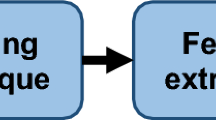Abstract
Classification of music signal is a fundamental step for organized archival of music collection and fast retrieval thereafter. For Indian classical music, raga is the basic melodic framework. Manual identification of raga demands high expertise which is not available easily. Thus an automated system for raga identification is of great importance. In this work, we have studied the basic properties of the ragas in North Indian (Hindusthani) classical music and designed the features to capture the same. Pitch based Swara (note) profile is formed. Occurrence and energy distribution of notes generated from the profile are used as features. Note sequence plays an important role in the raga composition. Proposed note co-occurrence matrix summarizes this aspect. An audio clip is represented by these features which have strong correlation with the properties of raga. Support vector machine is used for classification. Experiment is done with a diversified dataset. Performance of the proposed work is compared with two other systems. It is observed that proposed methodology performs better.





Similar content being viewed by others
References
Chakravorty, J., Mukherjee, B., Datta, A.: Some studies on machine recognition of ragas in indian classical music. J. Acoust. Soc. India XVII(3 & 4), 1–4 (1989)
Chordia, P., Rae, A.: Raag recognition using pitch- class and pitchclass dyad distributions. In: Proceedings of International Society for Music Information Retrieval Conference, pp. 431–436 (2007)
Cortes, C., Vapnik, V.: Support-vector networks. Mach. Learn. 20(3), 273–297 (1995)
Das, D., Choudhury, M.: Finite state models for generation of Hindustani classical music. In: Proceedings of International Symposium on Frontiers of Research in Speech and Music, pp. 59–64 (2005)
Dighe, P., Agrawal, P., Karnick, H., Thota, S., Raj, B.: Scale independent raga identification using chromagram patterns and swara based features. In: Proceedings of International Conference on Multimedia and Expo Workshops, pp. 1–4 (2013)
Dutta, S., Murthy, H.A.: Raga verification in carnatic music using longest common segment set. In: Proceedings of International Society for Music Information Retrieval Conference, pp. 605–611 (2015)
Katz, J.: Dhrupad: tradition and performance in Indian music. Ethnomusicol. Forum 14(1), 113–115 (2005)
Koduri, G.K., Gulati, S., Rao, P., Serra, X.: Rga recognition based on pitch distribution methods. J. New Music Res. 41(4), 337–350 (2012)
Koduri Gopala-Krishna, S.G., Rao, P.: A survey of raaga recognition techniques and improvements to the state-of-the-art. In: Sound and Music Computing, pp. 33–40 (2011)
Krishnaswamy, A.: Melodic atoms for transcribing carnatic music. In: Proceedings of International Society for Music Information Retrieval Conference, pp. 345–348 (2004)
Kumar, K.P., Rao, M.S.: Raaga identification using clustering algorithm. In: International Conference on Electrical, Electronics, and Optimization Techniques, pp. 2077–2081 (2016)
Kumar, V., Pandya, H., Jawahar, C.V.: Identifying ragas in Indian music. In: International Conference on Pattern Recognition, pp. 767–772 (2014)
Müller, M., Ewert, S.: Chroma Toolbox: MATLAB implementations for extracting variants of chroma-based audio features. In: Proceedings of International Conference on Music Information Retrieval, pp. 215–220 (2011)
Müller, M., Kurth, F., Clausen, M.: Audio matching via chroma-based statistical features. In: International Conference on Music Information Retrieval, pp. 288–295 (2005)
Pandey, G., Mishra, C., Ipe, P.: Tansen: a system for automatic raga identification. In: Proceedings of International Conference on Artificial Intelligence, pp. 1350–1363 (2003)
Platt, J.C.: Sequential minimal optimization: a fast algorithm for training support vector machines. Technical Report MST-TR-98-14. Microsoft Research (1998)
Pranay, D., Harish, K., Bhiksha, R.: Raga verification in carnatic music using longest common segment set. In: Proceedings of International Society for Music Information Retrieval Conference, pp. 605–611 (2013)
Rao, P., Ross, J.C., Ganguli, K.K., Pandit, V., Ishwar, V., Bellur, A., Murthy, H.: Classification of melodic motifs in raga music with time-series matching. J. New Music Res. 43(1), 115–131 (2014)
Ross, J.C., Rao, P.: Detection of raga-characteristic phrases from Hindustani classical music audio. In: Proceedings of CompMusic Workshop, pp. 133–138 (2012)
Salamon, J., Gomez, E.: Melody extraction from polyphonic music signals using pitch contour characteristics. IEEE Trans. Audio Speech Lang. Process. 20(6), 1759–1770 (2012)
Sharma, M.: Tradition of Hindustani Music. A.P.H. Publishing Corporation, New Delhi (2006)
Shetty, S., Achary, K.K.: Raga mining of Indian music by extracting arohana-avarohana pattern. Int. J. Recent Trends Eng. 1(1), 362–366 (2009)
Singh, J.: Interview with Pandit Jasraj. https://www.youtube.com/watch?v=VPshheRL69M (2016). (You Tube; Accessed 10 Sept 2016)
Sinith, M., Rajeev, K.: Hidden Markov model based recognition of musical pattern in south Indian classical music. In: Proceedings of International Conference on Signal and Image Processing, Hubli, India (2006)
Sridhar, R., Geetha, T.V.: Raga identification of carnatic music for music information retrieval. Int. J. Recent Trends Eng. 1(1), 571–574 (2009)
Viswanathan, T., Allen, M.: Music in South India: The Karāak Concert Tradition and Beyond: Experiencing Music, Expressing Culture. Global Music Series. Oxford University Press, Oxford (2004)
Wade, B.: Chz in khyl: the traditional composition in the improvised performance. Ethnomusicology 17(3), 443–459 (1973)
Acknowledgements
Rajib Sarkar thanks University Grants Commission (UGC), India for his fellowship.
Author information
Authors and Affiliations
Corresponding author
Rights and permissions
About this article
Cite this article
Sarkar, R., Naskar, S.K. & Saha, S.K. Raga identification from Hindustani classical music signal using compositional properties. Comput. Visual Sci. 22, 15–26 (2019). https://doi.org/10.1007/s00791-017-0282-x
Received:
Accepted:
Published:
Issue Date:
DOI: https://doi.org/10.1007/s00791-017-0282-x




